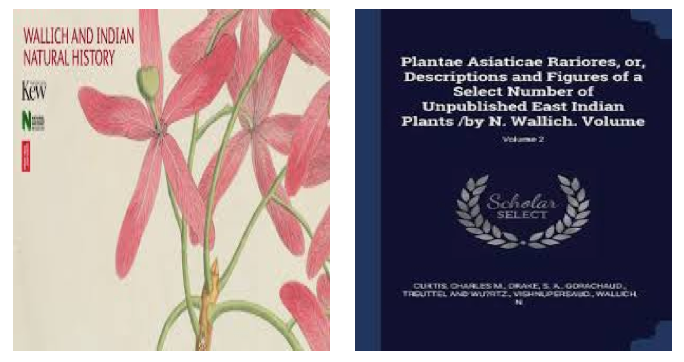[Originally published as part of my Column “Green Cardamoms “ in Shillong Times, Canvas, page 3].
Wallichi-Nama
Author: Gaurangi Maitra

photo credits: www.kew.org & www.bookdepository.com
Memory tags: The 2nd of February, 2014, advertisement in the Times of India for the Nathaniel Wallich Memorial Lecture by RomilaThapar to mark the Bicentennial of the Indian Museum, Kolkata.
In a century, when wars were fought, fortunes lost and regained and revolutions waged around plants that changed human civilization, the plant collectors, collections and gardens inevitably played a central role. Sketched or photographed, pressed between herbarium sheets or transported live, stolen or gathered in seeds, the amateur or professional collectors have always managed to bring home or report the story. This ancient human commerce institutionalized in gardens & collections around the world and updated by foraging botanists. Thus it was no surprise when on the 2nd of February, 2014, the Times of India carried a large advertisement on the Nathaniel Wallich Memorial Lecture to be delivered by the famous historian Romila Thapar on the day of the Inaugural Ceremony to mark the Bicentennial of the Indian Museum, Kolkata. Two hundred years ago, 2nd February, 1814 marked the day, on which Nathaniel Wallich had written to the Asiatic Society to set up a museum. This proposal was comprehensively backed by the society so the “Jadughar”(as it is commonly called) of modern, independent India started as the Oriental Museum of the Asiatic Society.Wallich not only contributed 40 of the 174 items that formed the initial nucleus in 1816 but worked as its first curator and then secretary till 1817.
By this time Nathaniel Wallich had spent almost a decade in India. He came from Denmark’s capital city of Copenhagen to take up his appointment as a surgeon to the Danish colony of Frederiksnagore or Serampore. In the political cross fire between European powers of the early 1800s, this Dutch settlement in India was annexed by Britain, which in turn made Wallace, a prisoner of war. Among his other qualifications, Wallich had studied botany under Professor Martin Vahl who in turn had been a student of Carolus Linneaus at Uppsala. This probably added to the fact that even, in those non digital times, plant collectors and botanists were well networked; so Wallich the prisoner of war became an accredited personnel of the British East India Company Service when the then Superintendent of then East India Company’s Garden (now called Acharya Jagdish Chandra Bose Indian Botanic Garden) asked for his services citing the merit of his scholarship. This enabled Wallich to begin his career as a plant collector and botanist as William Roxburgh’s assistant. He would become in 1817, the third Superintendant,serving the garden in this capacity till 1846.When Joseph Dalton Hooker visited it two years later, he would write “contributed more useful ornamental tropical plants to the public and private gardens of the world than any other establishment before or since.”
By a strange quirk of fate or inevitability of circumstances, this prolific botanist, Wallich is not half as famous as his contemporaries.David Arnold writes of Wallich’s career in his book,Nathaniel Wallich and the Natural History of India as“one of frustration and failure to achieve the lasting recognition his intellect, perseverance and opportunity seemingly deserved.” This of the man who collected, documented, employed able illustrators like Visnhu Prasad of Hitopadesha fame , took a two year sabbatical(1828-32) to publish his humungous East India Herbarium, visited and documented plants from Nepal; used his Serampore connections with William Carey at the Baptist printing press to bring out Roxburgh’s massive Flora Indica and was at the heart of the controversy that delayed identification of the tea plants from Assam by a whole decade. He initially and famously declared they were not tea plants; but made up by supporting the whole tea plantation venture in a host of other ways.
Whatever the fickle ways of fame and fortune, the botany of the Indian subcontinent is deeply indebted to this plant collector-botanist. Beyond the stewardship of these two very worthy institutions,his collection has an unbelievable tally of 20,500 specimens divided between the “Wallich Herbarium” at Kew Gardens in UK and the Central National Herbarium of the Botanical Survey of India in Kolkata.And, all plants or animals named in his honour carry wallichii at the end. So it is more than fitting to call this short piece the overture to a full Wallichinama, time and space permitting at a later date.
Main resources:
- Gaurangi Maitra,"Contributions of Nathaniel Wallich in the Context of His Time and Habitats" 2014,Keanean Journal of Science, Vol 3, 53-60.
